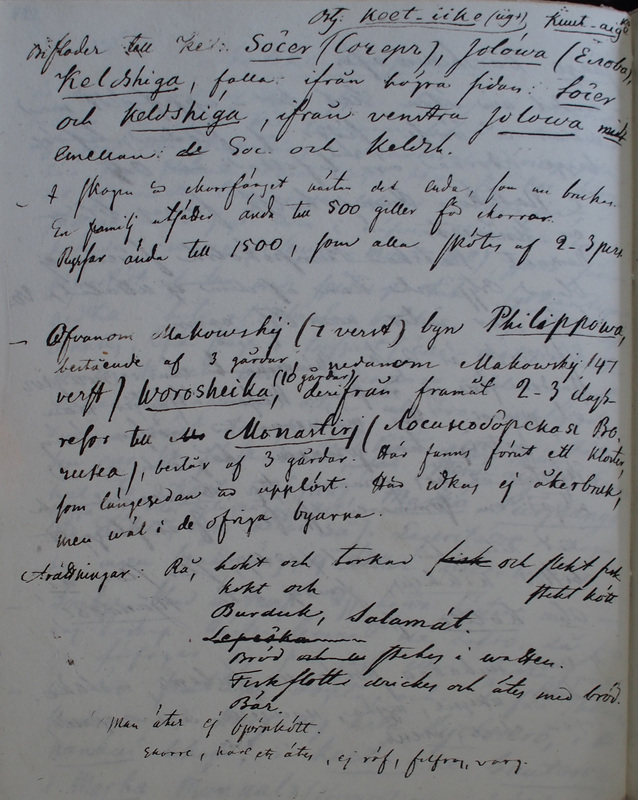Ethnographiska, historiska och statistiska anmärkningar. 224
Title
Ethnographiska, historiska och statistiska anmärkningar. 224
Description
| Bifloder till Ket: Soĉer (Сочеръ), Ostj.[Ostjakiska] Koet-iike (iige), Kuut-aig, Jolówa (Елова) Keldshiga, falla ifrån högra sidan: Soĉer och Keldshiga, ifrån venstra Jolowa midt emellan: Soc. [Soĉer] och Keldsh. [Keldshiga] |
Tributaries of the River Ket: Soĉer (Sočerʹʹ), in Ostyak Koet-iike (iige), Kuut-aig, Jolówa (Elova), Keldshiga, flowing from the right-hand side: Soĉer and Keldshiga, from the left; Jolowa in between: Soc. [Soĉer] and Keldsh. [Keldshiga] |
| I skogen är ekorrfånget nästan det enda, som nu brukas. En familj utsätter ända till 500 giller för ekorrar. Ryssar ändatill 1500, som alla skötas af 2-3 pers. |
In the forest, squirrel hunting is almost the only thing practised nowadays. One family sets up to 500 squirrel traps and the Russians as many as 1500, taken care of by two or three persons. |
| Ofvanom Makowskij (7 verst) byn Philippowa, bestående af 3 gårdar; nedanom Makowskij (47 verst) Worosheika (10 gårdar), derifrån framåt 2-3 dags resor till Monastirj
(Лосиноборская Во-Losinoborskij Preobražesnkij monastirʹ (Ketskaja pustynʹ), founded in the early 1670s (Mankova 2017).
чина) består af 3 gårdar. Här fanns förut ett kloster, som längesedan är upplöst. Här idkas ej åkerbruk, men wäl i de öfriga byarna. |
Above Makowskij (7 versts) the village of Philippowa, consisting of three farms; below Makowski (47 versts) Worosheika (ten farms), from there onwards after two or three days’ travel Monastirj (Losinoborskaja Vočina) consists of three farms. There used to be a monastery here, which was closed down a long time ago. The fields are not cultivated here, but it is done well in the other villages. |
|
A[n]rättningar:
Rå, kokt och torkad fisk och stekt fiskThe Selkup diet is dominated by fish, as can be seen in this list but also in other ethnographic descriptions. See Tučkova 2005: 347–350.
kokt och stekt kött Burduk, Salamåt
In Siberia and the Arkhangel’sk region the Ru burduk (burda) refers to a meat soup thickened with a considerable amount of flour, also Ru salamata, TN я. А bouillon with meat, TN евей. (Dalʹ 1994a: 349; Dal’ 1994b: 12; Chomič 1966: 134)
Bröd stekes i watten. Fiskflott drickes och ätes med med bröd. Bär Man äter ej björnkött. Ekorre, hare etc. ätes, ej räf, filfras, varg. |
Dishes: Raw, cooked and dried and fried fish Bread is made with water. |

